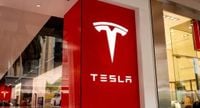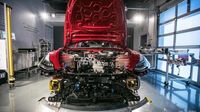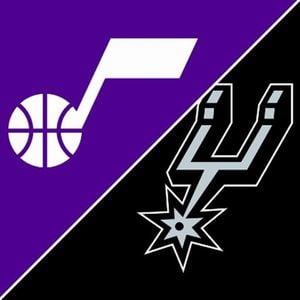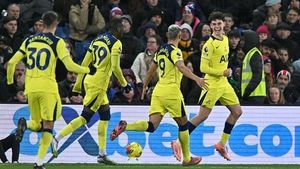In a dramatic turn of events that’s reverberated across Silicon Valley and beyond, Tesla is facing a $51 million lawsuit from one of its own robotics technicians, Peter Hinterdobler. The suit, filed in California in September 2025, alleges that a catastrophic workplace accident at Tesla’s Fremont, California, factory left Hinterdobler with severe, life-altering injuries and staggering medical bills. The case comes at a particularly sensitive moment for Tesla, as the electric vehicle pioneer’s grip on the market is already showing signs of slipping, and its ambitious robotics push is drawing heightened scrutiny.
According to the San Francisco Chronicle and multiple other outlets, the incident occurred in July 2023, when Hinterdobler, 50, was assisting an engineer in disassembling a robot at the Fremont plant. Suddenly, and without warning, the machine’s arm released with what Hinterdobler describes as “great force.” The power of the mechanical arm, combined with the immense weight of an 8,000-pound counterbalance, knocked Hinterdobler unconscious and left him sprawled on the factory floor. He claims the accident resulted in serious injuries, and he’s already racked up $1 million in medical expenses, with at least $6 million more in treatment expected in the future.
Hinterdobler’s lawsuit doesn’t just target Tesla; it also names FANUC America, a Japanese robotics company that built the machine he says injured him. In his filing, Hinterdobler alleges that Tesla failed to ensure the robot’s mechanics were secure and that the equipment was neither “safely de-energized, secured and stable” while he was working on it. He further claims that the robot’s placement at the Fremont facility was “not designed for such equipment,” suggesting systemic safety oversights at the plant.
As reported by Daily Mail, Hinterdobler is seeking $51 million in total damages. The breakdown is telling: $20 million for physical pain, $10 million for emotional distress, $1 million in lost wages, $8 million for lost future earnings, and $5 million for “past and future loss of household services.” These figures underscore the scale of the alleged harm and the long-term impact on Hinterdobler’s life and livelihood. “The machine’s arm suddenly and without warning released with great force,” Hinterdobler states in his lawsuit, emphasizing the unpredictability and violence of the accident.
The lawsuit also claims that Tesla introduced new safety protocols for the robot after the incident, a move Hinterdobler argues is tacit acknowledgment that previous precautions were insufficient. FANUC, for its part, is accused of negligence in the design of the equipment. Both Tesla and FANUC have so far declined to comment on the lawsuit, leaving many questions unanswered about the precise sequence of events and the companies’ internal safety standards.
The timing of the suit is far from ideal for Tesla or its high-profile CEO, Elon Musk. As TipRanks and other financial outlets report, the news rattled investors, causing Tesla shares to slide by over 3% during Thursday afternoon trading in late September 2025. The incident comes on the heels of a worrying trend for the company: Tesla’s once-dominant share of the U.S. electric vehicle market is eroding, with only 38 percent of new EV owners now driving a Tesla—the first time in nearly eight years that the company’s market share has dipped below 40 percent.
Industry analysts have pointed to a variety of factors for this decline. Tesla has faced criticism for the high price of its vehicles, which some consumers now view as unaffordable. Meanwhile, competitors like Hyundai, Chevy, and Kia have rolled out newer, more affordable electric models, luring away budget-conscious shoppers. Political controversies have also played a role; some EV buyers, who tend to lean liberal, have publicly vowed to boycott Tesla over Musk’s previous role as a White House advisor to Donald Trump, a position that saw him advocate for deep federal spending cuts.
Tesla’s last major product launch, the angular Cybertruck, was initially expected to be a blockbuster. Musk boasted of “over one million reservations” a month before the truck’s release. But reality has fallen short: in the two years since its $72,000 debut, Tesla has sold only about 52,000 Cybertrucks. This underwhelming performance has only added to concerns about the company’s future trajectory.
Undeterred, Tesla has doubled down on its vision for the future. On September 1, 2025, the company unveiled its much-anticipated “Master Plan 4,” a sweeping roadmap that puts artificial intelligence and robotics at the heart of Tesla’s ambitions. The plan includes promises of humanoid robots capable of cleaning homes and autonomous vehicles that forgo traditional steering wheels and rearview mirrors. “We must make one thing clear: this challenge will be extremely difficult to overcome,” Tesla wrote in the plan, acknowledging the formidable obstacles ahead.
That bet on the future is also tied directly to Musk’s own compensation. Tesla’s board has proposed a staggering $1 trillion pay package for the CEO, contingent on the success of these next-generation technologies and the company’s valuation soaring to $8.5 trillion over the next decade. It’s a bold wager, one that hinges on Tesla’s ability to deliver breakthroughs in AI and robotics—fields now under even greater scrutiny in light of Hinterdobler’s lawsuit.
The case has also cast a spotlight on workplace safety in the rapidly evolving world of industrial robotics. As factories become more automated and robots take on increasingly complex roles, the potential for accidents—especially catastrophic ones—remains a pressing concern. Hinterdobler’s ordeal is a stark reminder that, for all the promise of automation, the risks are real and can have devastating personal and financial consequences.
For now, the legal battle is just beginning. The outcome of Hinterdobler’s lawsuit could set important precedents for how companies like Tesla and their suppliers are held accountable for workplace accidents involving advanced robotics. It may also force a broader reckoning within the industry about the balance between innovation, productivity, and safety.
As Tesla continues to chase its ambitious vision of an AI-powered future, the company—and the world—will be watching closely to see how it responds to the human cost of its technological revolution.





